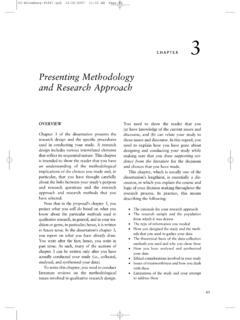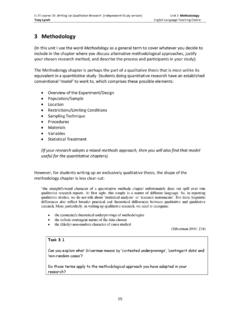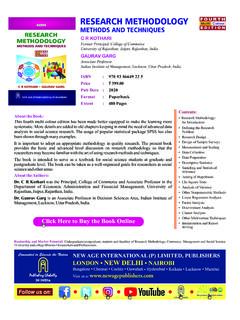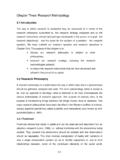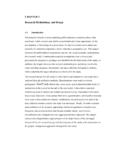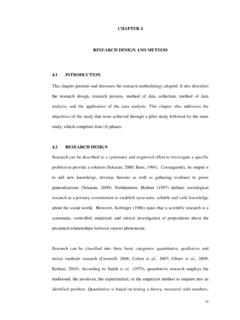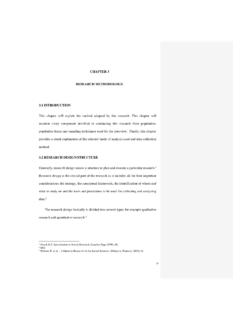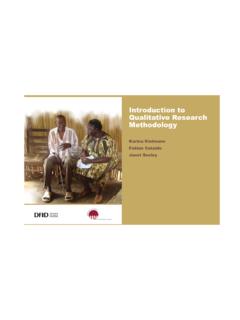Transcription of Chapter 3: Research Methodology 3.1 Introduction
1 66 Chapter 3: Research IntroductionResearch Methodology is basically a portmanteau. It is the correlation of the two that makes up a significant part of the most important field of scientific Research and technology (Kumar, 2005). Research is the quest for knowledge, to weigh, evaluate and observe facts in order to explain opaque proceedings (Kothari, 2005). It is the systematic investigative delving into an unknown scientific process, whereas Methodology is the system of methods followed in a particular discipline. Methodology includes a collection of theories, concepts, ideas, and ideologies as they relate to a particular discipline or field of inquiry (Yin, 2003). To put it simply, the two linked together come to mean inquiry of facts within a particular field using a particular method suited to that field. In layman s terms, Research is the surgeon about to perform a surgery and the Methodology is the tool (Ad r and Mellenbergh, 1999).
2 To clarify further, one cannot delve into the realms of a particular field unless he or she applies the correct tool. After all, one can hardly use surgical instruments for cooking (Detterman, 1985). In the same way, a specific Methodology must be applied to a particular field of Adopted Research MethodologyThe organization which is the focus of the adopted Research Methodology is the National Health Services. The National Health Service has been taken and analyzed in order to determine whether public health services are implementing job evaluation in a manner such that it is abiding by the basic principles of pay equity. The Research Methodology that has been adopted to determine whether or not pay equity serves to improve work conditions is one of a qualitative analysis Secondary Source: Article AnalysisThe secondary source for this paper is one that makes use of a specific number of articles to perform a qualitative analysis.
3 The articles have been selected on the basis of specific criteria which have been discussed under a separate heading in the paper. Each article has been analysed individually and the findings extracted from the articles have then been put together to form a definite derivative conclusion of sorts. Qualitative AnalysisAs mentioned above, the Research Methodology for the paper is one that has been designed to follow a qualitative analysis. The qualitative analysis allows for an in-depth understanding of the Research subject to be acquired. The qualitative analysis is generally used in situations where the subject of Research at hand is one that incorporates a significant degree of study of behavioral attributes or the study of trends that cannot be expressed using quantitative order to carry out this qualitative analysis effectively, the literature review was brought into use.
4 The literature review, unlike the literature review that rudimentary studies incorporate, was a critical literature review and served to present a critical analysis of the selected articles. Each article was critically analyzed whereby the discussion presented on each article was not limited to a description or summary of its order to conduct a Research based on qualitative analysis, it is essential to analyze the documentation related to the subject under observation. More than often, peer-reviewed publications are analyzed in an attempt to develop a clear understand of the trends and tendencies that exist in the subject being analyzed (McNabb, 2004). Performance of the Qualitative AnalysisThe qualitative analysis in this Research study has been performed in a two-step process. The very first step is that of the execution of the critical literature review. Once the articles mentioned had been analyzed and evaluated for their reviews and their findings, the critical literature review Chapter came to a close.
5 The second step was then carried out in the findings Chapter , where the essential findings from the critical literature review were subjected to a critical appraisal. It is in the same Chapter that the findings of the critical literature review shall be Search StrategyThe search strategy was one that was based on the singling out of particular articles that could be expected to contribute to this Research . A particular criterion was developed and followed to carry out an organized and comprehensive search strategy. This was done in order to ensure that the articles incorporated into the Research were credible and could be trusted to provide the Research with a sufficient understanding of the subject of the Research study. It is for the same reasons that the number of articles to incorporate in this Research study was limited to a maximum of six Criteria for the Selection of Articles for the Critical Literature ReviewThe articles selected for the literature review were based on specific criteria.
6 The first essential requirement was that the articles had to be related to job evaluation at all costs. The second prerequisite was that the articles could not be mere discussions on job evaluation, preferably attempting to provide the Research with critical findings so as to allow this Research to expand the horizon. It is essential to highlight at this point that special consideration and preference was given to articles that were related to NHS job evaluation in Justification for the use of the Qualitative ApproachThe qualitative approach has been employed in this Research study because of the fact that there are hardly any elements of this Research that can be considered to be of a nature that could be subjected to statistical comparison and/or calculation. Much of the study regarding the NHS job evaluation is one that has been performed through the use of peer-reviewed publications, and since job evaluation in itself is a process that is highly qualitative procedure in excesses, it would have only served to decrease the credibility, authenticity, and reliability of the Research and its findings had a quantitative approach been qualitative analysis generally proceeds by analyzing the cause and effect relationships that exist in a naturally existing setting.
7 The researcher delves into the numerous variables pertaining to the scenario, and attempts to acquire an understanding of the scenario that is often argued to be non-generalizable. This is because of the fact that in the case of the application of a qualitative analysis, the Research has to be anchored to a specific context and has to operate within the perimeters of that context. Generally, qualitative data once accumulated through secondary sources is subjected to extensive analysis in an attempt to confirm or disclaim pre-existing perceptions regarding the Research is essential to understand that while the argument between the legitimacy of qualitative and quantitative analysis is one that holds credibility and the result of which may serve to revolutionize the way modern day Research is carried out, the present scenario merits that the approach most suitable to the subject of Research is selected and implemented.
8 This is because of the fact that both Research approaches have specific attributes and while each Research approach may differ from the other in a number of ways, they are both meant to facilitate the effective execution of the Critical Appraisal Skills Program (CASP)This is an assessment tool which has been created to aid those individuals who are unfamiliar with qualitative Research and its theoretical perspectives. This tool is used to identify within Research studies the various theories and assumptions which characterize qualitative Research . In order to accomplish this task, the program employs the use of ten questions which are used to broach four issues which may be addressed in studies using qualitative Research . These issues consist of rigor which contends whether a thorough approach has been applied to the study. Another issue which is given consideration is the key Research methods within the study and whether the findings from these methods employ any form of credibility.
9 Finally, the relevance of the findings of the study at an individual and at an organizational level is considered within the program. The first two questions within the appraisal tool are screening questions which are used to ascertain whether the study in question does employ qualitative theories in its Research . The first question considers what the study aims to accomplish. The second question gives consideration to whether qualitative Research should be employed in this study. Answering these two questions leads to a more detailed assessment of the study in question by asking if the researcher has given justification for the Research design employed. This is followed by another which asks how the participants of the survey were chosen, how the most appropriate participants can be chosen to maximize the pertinent knowledge required in this case, and why certain participants may be reluctant to take part in the survey.
10 71 This is followed by a question regarding the collection of data which asks whether the Research data collection is justified. The collection of this data is further explored by asking the methods of collection of data, the form of data collected, the Methodology of data collection, and the saturation of this the reflexivity of the data is explored which gives consideration to the relationship between the researcher and the participants of the study. This question explores the inherent personal bias of the researcher, as well as how the questions were made and data was collected. There is also consideration given to how the researcher has responded to any changes within the Research design. This is followed by an exploration of the ethical design of the study which discusses issues of ethical standards within the study, as well as those related to the participants, such as informed consent and confidentiality.



